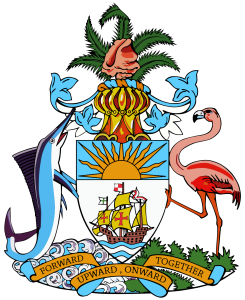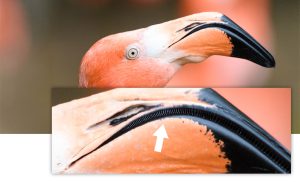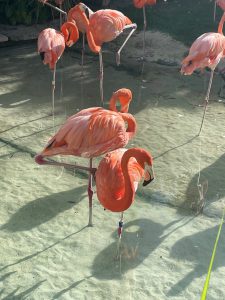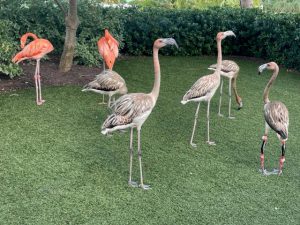
Florida is known for its kitschy plastic lawn flamingos—a throwback to the 1950’s era of aspirational, semitropical suburban bliss. But if you head a little farther south, you get a lot more of the real thing. These elegant neon pink wading birds are the mascot and national bird of the Bahamas, due to their once-large (and now growing again) native populations.
One a recent trip to the area, I had an opportunity to see several flamingos (Phoenicopterus ruber) up close. I was intrigued by the babies—a handful of 4-month-old birds goofed around with their caretakers and generally acted like toddlers. As young birds, their feathers are gray and white. It takes time to develop the brilliant pink coloration for which their species is known. One of the rather fascinating attributes of flamingos and the similarly shaded roseate spoonbill is the source of that coloration–it all comes down to diet. Flamingos are wetland wading birds, spending their lives in and around coastal salt marshes and feeding on the smaller creatures in those habitats.

While they don’t resemble your typical filter feeder, flamingos have structures on their bill and tongue called lamellae. These are used to take up blue-green algae, brine shrimp, and larvae. The Carribbean flamingo also has a wider mandible than other species allows them to eat bigger food. All of these food sources, particularly the algae, are full of beta carotene, which contains pink and orange pigmentation that gives them their brilliant vermillion plumage. Flamingos’ livers break down the pigments into individual molecules that are absorbed by fats and deposited into their bills, feathers, and legs. Even their webbed feet are pink! A similar phenomenon occurs with the green sea turtle, so named because the green algae they ingest colors their body fat.

Flamingos are also rather unique in the span of both their wings and their lives. An adult flamingo can have a wingspan of up to 5 feet. They may live up to 60 years or more in the wild! Casual observers and scientists alike have long been curious about why flamingos tend to stand on one leg, especially when sleeping. A couple of theories exist on this, including being more comfortable (their knee joints lock easily), conservation of heat in wet (and sometimes cold) environments, and/or their ability to allow just half their body to fall asleep, resulting in one leg resting while the other “works.”

The Bahamian flamingo population, along with a smaller one in south Florida, is a success story of bringing a beloved species back from the brink of extinction. Like many coastal birds, they were hunted relentlessly for the feather and hat trade in the 19th century. By the beginning of the 20th, they had essentially disappeared from Florida. A small population was reintroduced to the Hialeah racetrack, which is now stable and includes naturally recruited birds. In the Bahamas, flamingos faced similar pressures from hunters. Air Force pilots stationed in the area often flew too low, deliberately scattering the birds for fun but seriously disturbing their nesting habits. The birds’ eggs were predated by wild pigs, to the point their population was down to 5,000 individuals in the wild by the 1950’s. The Audubon Society worked with a pair of local hunters to find and protect a large flock, and these efforts (along with laws preventing harvesting eggs and low flying) helped bring the population to over half a million birds today. The salt production industry has a healthy relationship with flamingos, providing habitat and food sources while the flamingos encourage algae growth, which helps in the salt evaporation process. This mutually beneficial arrangement helps protect flamingo populations for ongoing generations.
 2
2
